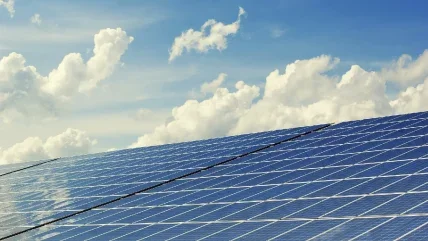
The Sobradinho Dam was built in the 1970s on the São Francisco River in Brazil. Originally used to produce electricity it also provided flood control, irrigation, navigation, and water supply. In 2016, the Brazilian government agreed to optimise the performance of the infrastructure and launched a research and development programme with this objective.
A floating solar power plant with a capacity of 1MW was established by Ciel & Terre to meet this need. The Sobradinho project foresees an electricity production of 1546MWh/year which will meet the consumption of 616 households and avoid 502 tons of CO2 equivalent per year.
The installation of a solar power plant always presents challenges related to site conditions. The anchoring of floating power plants on dam projects is the most complex factor due to the depth of reservoirs. In the case of the Sobradinho solar island, a specific and customised solution was designed for the anchoring to accommodate the site's depth of up to 29.3m and its water level variation of up to 13m. Previously in 2016, Ciel & Terre also had to adapt to the constraints of the reservoir of a dam through the Alto Rabagao floating solar project in Portugal.
Benefits and advantages
The combination of floating solar and dam technology adds to their own individual strength. Indeed, the floating structure significantly increases the dam's power generation capacity and the floating solar power plant thus benefits from the electrical structures of the hydroelectric dam. As a result, the electricity produced is from a more environmentally friendly hybrid system.
From an environmental point of view, the production of cleaner energy is not the only benefit of using a water body as the limitation of evaporation is one of the major advantages of floating solar power plants. Algae growth is also reduced as the photosynthesis process is impacted by the number of solar panels deployed on the water surface, while seasonality also loses its influence on ponds with a such installations.
Moreover, the use of the available water surfaces makes it possible to optimise their yield without using land with added value. This helps to preserve environmental resources while meeting local needs. Furthermore, floating solar also enables a cooling effect thanks to water proximity which improves the PV panel’s energy production capacity. Indeed, some studies have demonstrated that it has a positive impact. For example, The Solar Energy Research Institute of Singapore has recorded the PV panels temperature from 3.2° to 14.5° degrees lower than solar systems on roofs installed in Singapore with an increase of the yield from 5 to 10%.
Globally, the electric energy produced by floating solar has a bright future with a potential market that keeps growing. According to the estimation of the energy expert, quality and risk management DNV in 2022, the potential of floating solar is estimated at 4TW and is a fast-growing market with a other possible applications for installation including quarries and mining lakes, water treatment plants, irrigation ponds, industrial or commercial reservoirs.
Improving technology
To address any environmental impacts of floating structures and so as not to impact biodiversity, preliminary environmental impact studies are carried out prior to the installation of a power plant on water. Depending on the results, Ciel & Terre takes the decision to cover only a certain percentage of the lake or to keep safe areas for fauna and flora.
Studies and research about the impact of floating solar plants on water quality have also been carried out. Experimental studies have highlighted how floating projects can impact the physical parameters of the water. Indeed if the coverage of a lake with the solar plant is too high there is an impact on the light intensity and water temperature. And in line with its commitment to Corporate Social Responsibility, Ciel & Terre continues to pursue its efforts by offering fully recyclable floats on its plants. The end of life of the power plants is a major stake and the company is currently working on its optimisation.
Different expertise
Floating solar is technically quite different from conventional solar power plants and the major issue comes with working with electricity on water. There are key parameters to take into account in the design of an FPV plant such as wind, current, bathymetry, waves, type of soil, water types, etc, all of which require a specific understanding of the sites themselves.
Ciel & Terre’s scope begins at the preliminary design stage up to the completion of the project (including maintenance services). Its project teams will manage and support their clients through the site analysis and then design the most suitable floating solar plants based on the environmental loads and the production needs.
In addition to the environment itself, one other big difference and challenge with floating solar is the anchoring of the installation which is very specific to floating solar. Such anchoring and mooring systems need to take into account water level variation, the elasticity ratio in case of reservoir draining for instance, or harsh wind conditions. Anchoring engineers define the best anchoring solution based on the site analysis with a customised design enabling the floating solar plants to last more than 30 years.
Ciel & Terre’s experience in the floating solar market means it has 280 projects to its credit and no less than 770MWp of installed capacity worldwide. Including projects currently being designed or under construction, there is more than 1.5GWp in the total pipeline of the French company. The company has already installed several projects on water bodies as various as quarry lakes, irrigation ponds, hydro dams, water treatment plants, industrial ponds, and waterways such as Kayamkulam project (73.4MWp), one of the latest FPV projects installed in India, but also protected shores like Changbin (88MWp) in Taiwan.
Currently, two other projects are under construction in Taiwan and India. The first one is the continuation of the initial Changbin scheme where the yield target is about 192MWp on a protected shore. The second located in India will reach 119MWp.






